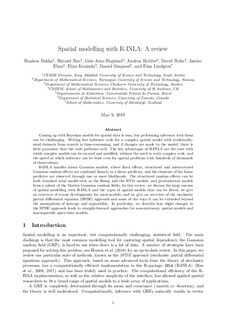| dc.contributor.author | Bakka, Haakon | |
| dc.contributor.author | Rue, Håvard | |
| dc.contributor.author | Fuglstad, Geir-Arne | |
| dc.contributor.author | Riebler, Andrea Ingeborg | |
| dc.contributor.author | Bolin, David | |
| dc.contributor.author | Illian, Janine B. | |
| dc.contributor.author | Krainski, Elias Teixeira | |
| dc.contributor.author | Simpson, Daniel | |
| dc.contributor.author | Lindgren, Finn | |
| dc.date.accessioned | 2018-12-19T14:32:02Z | |
| dc.date.available | 2018-12-19T14:32:02Z | |
| dc.date.created | 2018-06-06T12:51:20Z | |
| dc.date.issued | 2018 | |
| dc.identifier.citation | Wiley Interdisciplinary Reviews: Computational Statistics. 2018, 10:e1443 (6), 1-33. | nb_NO |
| dc.identifier.issn | 1939-5108 | |
| dc.identifier.uri | http://hdl.handle.net/11250/2578372 | |
| dc.description.abstract | Coming up with Bayesian models for spatial data is easy, but performing inference with them can be challenging. Writing fast inference code for a complex spatial model with realistically‐sized datasets from scratch is time‐consuming, and if changes are made to the model, there is little guarantee that the code performs well. The key advantages of R‐INLA are the ease with which complex models can be created and modified, without the need to write complex code, and the speed at which inference can be done even for spatial problems with hundreds of thousands of observations. R‐INLA handles latent Gaussian models, where fixed effects, structured and unstructured Gaussian random effects are combined linearly in a linear predictor, and the elements of the linear predictor are observed through one or more likelihoods. The structured random effects can be both standard areal model such as the Besag and the BYM models, and geostatistical models from a subset of the Matérn Gaussian random fields. In this review, we discuss the large success of spatial modeling with R‐INLA and the types of spatial models that can be fitted, we give an overview of recent developments for areal models, and we give an overview of the stochastic partial differential equation (SPDE) approach and some of the ways it can be extended beyond the assumptions of isotropy and separability. In particular, we describe how slight changes to the SPDE approach leads to straight‐forward approaches for nonstationary spatial models and nonseparable space–time models. | nb_NO |
| dc.language.iso | eng | nb_NO |
| dc.publisher | Wiley | nb_NO |
| dc.title | Spatial modelling with R-INLA: A review | nb_NO |
| dc.type | Journal article | nb_NO |
| dc.type | Peer reviewed | nb_NO |
| dc.description.version | acceptedVersion | nb_NO |
| dc.source.pagenumber | 1-33 | nb_NO |
| dc.source.volume | 10:e1443 | nb_NO |
| dc.source.journal | Wiley Interdisciplinary Reviews: Computational Statistics | nb_NO |
| dc.source.issue | 6 | nb_NO |
| dc.identifier.doi | 10.1002/wics.1443 | |
| dc.identifier.cristin | 1589425 | |
| dc.relation.project | Norges forskningsråd: 240873 | nb_NO |
| dc.description.localcode | Locked until 5.7.2019 due to copyright restrictions. This is the peer reviewed version of an article, which has been published in final form at [https://doi.org/10.1002/wics.1443]. This article may be used for non-commercial purposes in accordance with Wiley Terms and Conditions for Self-Archiving. | nb_NO |
| cristin.unitcode | 194,63,15,0 | |
| cristin.unitname | Institutt for matematiske fag | |
| cristin.ispublished | true | |
| cristin.fulltext | postprint | |
| cristin.qualitycode | 1 | |
